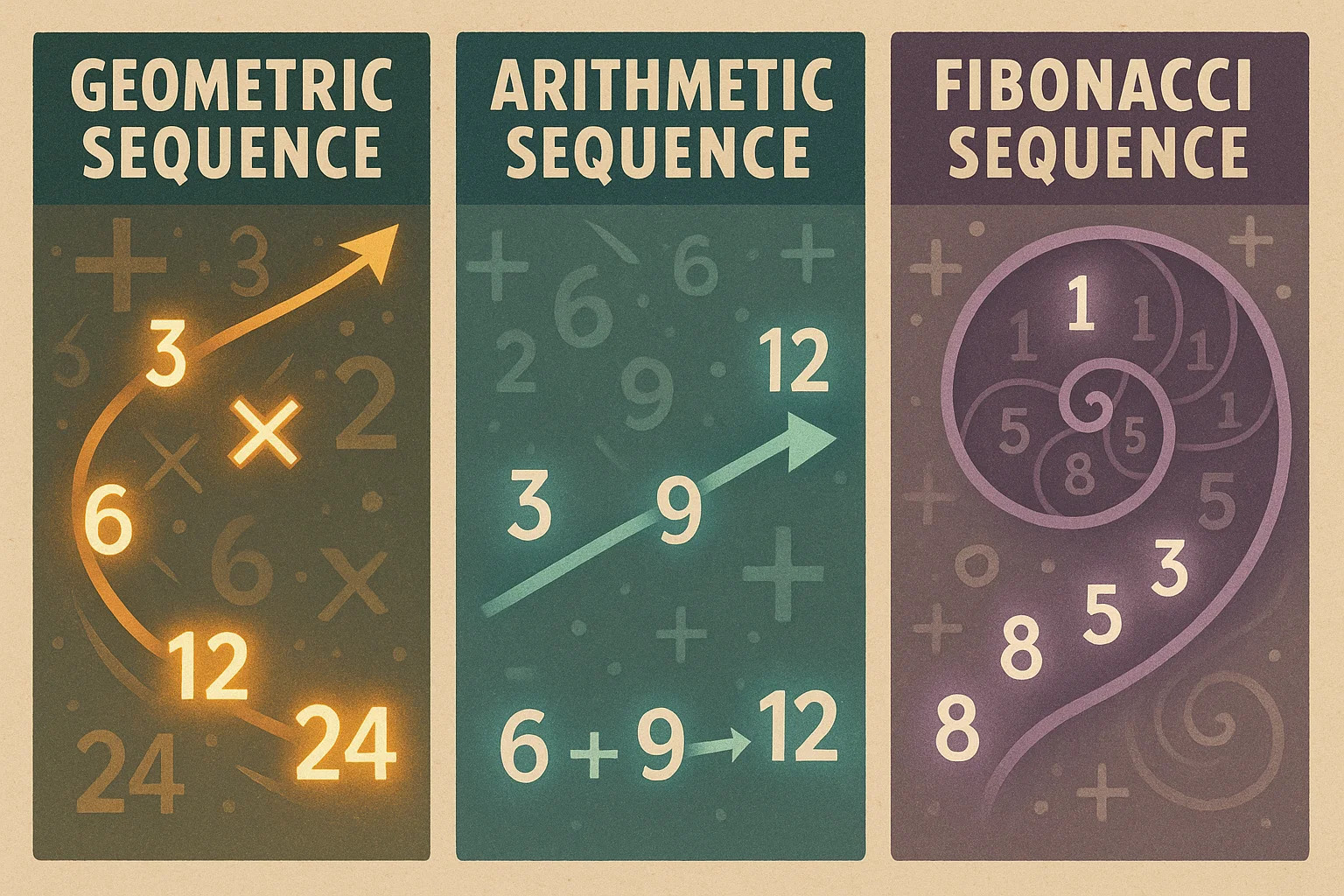Geometric sequences appear everywhere — from the growth of savings accounts to the spread of bacteria and even puzzles like the Tower of Hanoi. Understanding how these sequences work can help you solve problems in math, finance, and science more easily. Let’s break down what a geometric sequence is, how it’s structured, and why it’s so widely used.
What Is a Geometric Sequence?
A geometric sequence is a list of numbers where each term is found by multiplying the previous term by a fixed number, called the common ratio. This ratio can be greater than 1 (showing growth), between 0 and 1 (showing decay), or even negative, which causes the terms to alternate in sign.
For example:
-
2,6,18,54,…has a common ratio of 3 (each term is 3× the previous).
-
100,50,25,12.5,…has a common ratio of 0.5 (each term is halved).
Geometric sequences differ from arithmetic sequences — where you add or subtract the same amount each time — because they rely on multiplication, not addition. This makes them ideal for modeling situations involving percentage changes, exponential growth, or decay, such as interest rates, investments, or natural processes. If you’re also working with additive patterns, check out our Arithmetic Sequence Calculator for a quick comparison.

The Formula for Geometric Sequences
To work with geometric sequences, you need two core formulas:
1. The nth Term Formula
This tells you how to find any term in the sequence without listing all the previous ones:
aₙ = a₁ × r⁽ⁿ⁻¹⁾
Where:
-
aₙis the term you’re finding, -
a₁is the first term, -
ris the common ratio, and -
nis the position of the term.
2. The Sum of a Finite Geometric Series
When you want to add up the first n terms, use:
Sₙ = a₁ × (1 − rⁿ) ÷ (1 − r) (r ≠ 1)
This formula is used in everything from calculating total interest earned to predicting population totals after several generations.
Quick Fact: Albert Einstein reportedly called compound interest (which follows a geometric sequence) the ‘eighth wonder of the world,’ because of how quickly values grow when repeatedly multiplied.
These formulas form the backbone of how we solve geometric sequence problems, whether for simple math exercises or complex financial modeling. For broader problem-solving beyond sequences, explore our Math Calculator, which covers equations, ratios, and other math functions.
How to Solve Geometric Sequence Problems
Solving problems with geometric sequences usually comes down to three main steps: finding the common ratio, calculating a specific term, and sometimes summing the series.
1. Finding the Common Ratio (r)
The common ratio is the number you multiply by to get from one term to the next. You can find it using:
r = aₙ ÷ a₍ₙ₋₁₎
Take any two consecutive terms and divide the later by the earlier.
Example: For the sequence 3, 6, 12, 24, …:
r = 6 ÷ 3 = 2
2. Calculating Any Term
Once you know r and the first term a₁, you can find any term using:
aₙ = a₁ × r⁽ⁿ⁻¹⁾
Example: The 10th term of 5, 15, 45, … (where r = 3):
a₁₀ = 5 × 3⁹ = 5 × 19,683 = 98,415
3. Summing Finite and Infinite Series
Sometimes, you need the sum of several terms (like when calculating total growth over time). Use:
Sₙ = a₁ × (1 − rⁿ) ÷ (1 − r), r ≠ 1
If you’re working with an infinite series and |r| < 1 (meaning the terms get smaller and approach zero), the series converges and the sum is:
S∞ = a₁ ÷ (1 − r)
Example (Infinite Series): For 10, 5, 2.5, … (with r = 0.5):
S∞ = 10 ÷ (1 − 0.5) = 20
Did You Know?
A bouncing ball problem — where each bounce is half as high as the last — is a real-world example of an infinite geometric series. Even though the ball bounces forever (theoretically), the total distance it travels is finite because the series converges.
Geometric Sequences vs. Other Sequences
While geometric sequences are based on multiplication, not all number patterns work this way. Two other common types of sequences you might encounter are arithmetic sequences and the Fibonacci sequence — and knowing the difference helps you pick the right method for solving problems.
Geometric vs. Arithmetic Sequences
-
A geometric sequence multiplies each term by a constant ratio (rrr).
Example: 3,6,12,24,…r=2). -
An arithmetic sequence adds or subtracts the same amount each time.
Example: 3,6,9,12,…(difference d=3).
If you’re working with an additive pattern instead, try our Arithmetic Sequence Calculator.
Geometric vs. Fibonacci Sequences
-
A Fibonacci sequence is not a constant ratio or difference — each term is the sum of the two previous terms: 1,1,2,3,5,8,….
-
Fibonacci numbers appear in nature (spirals in shells, sunflowers) and growth modeling, but they don’t grow by a fixed ratio like geometric sequences.
If you’re exploring patterns like Fibonacci, check out our Fibonacci Sequence Calculator. For other types of patterns, our Number Sequence Calculator can help you explore different sequence types.


